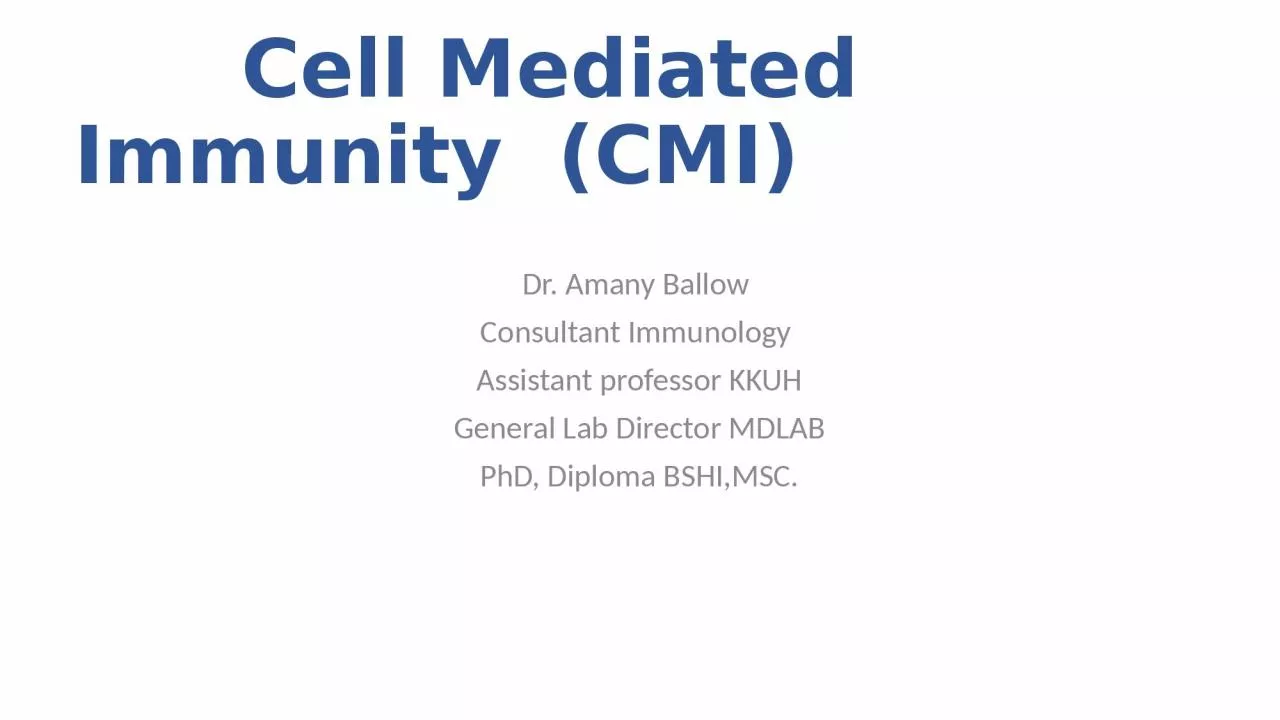

Dr Amany Ballow Consultant Immunology Assistant professor KKUH General Lab Director MDLAB PhD Diploma BSHIMSC Objective To describe antigen recognition by T cells To describe the pathways involved in processing endogenous and exogenous antigens ID: 1036517
Download Presentation The PPT/PDF document "Cell Mediated Immunity (CMI)" is the property of its rightful owner. Permission is granted to download and print the materials on this web site for personal, non-commercial use only, and to display it on your personal computer provided you do not modify the materials and that you retain all copyright notices contained in the materials. By downloading content from our website, you accept the terms of this agreement.
1. Cell Mediated Immunity (CMI) Dr. Amany Ballow Consultant Immunology Assistant professor KKUHGeneral Lab Director MDLABPhD, Diploma BSHI,MSC.
2. ObjectiveTo describe antigen recognition by T cells To describe the pathways involved in processing endogenous and exogenous antigensTo discuss self MHC restriction in Ag presentation to T cellsTo describe the induction of cell meditated immunity (Chronic Inflammation)
3. Immune system
4. Characteristics of Adaptive ImmunityAntigenic specificity.Diversity- can recognize > billion different antigens.Immunological memorySelf vs non-self recognition
5. Adaptive Immune Response Mediated Predominantly By Cells
6. Cell Mediated Immunity (CMI) T cells (lymphocytes) bind to the surface of other cells (Antigen Presenting Cells) that display the antigen and trigger a response.Mononuclear cell inflammatory process usually associated with chronic inflammations.
7. Cell-Mediated Immunity
8. Antigen Presenting cellsMonocytes : Peripheral bloodMacrophages : TissuesDendritic cells : Lymphoid tissues Langerhans cells : EpidermisB-cells : Lymphoid tissue, blood
9. LymphocyteMacrophages Lymphocyte
10. Major Histocompatibility Complex (MHC) (MHC) proteins were discovered for the first time with when tissue transplantation startedThe success of tissue and organ transplantation depends upon the match of donor’s and recipient’s “human leukocyte antigens” (HLA) encoded by HLA genesGenes for HLA proteins are clustered in the MHC complex located on the short arm of chromosome 6
11.
12. Major Histocompatibility Complex (MHC)Three genes code for Class I MHC moleculesHLA-A, HLA-BHLA-C HLA-D loci encode for Class II MHC molecules i.e.,DP DQ DREach group of MHC consists of several glycoproteins
13. Major Histocompatibility Complex (MHC)Each individual has two “haplotypes” i.e., two sets of these genes one paternal and one maternalMHC Class I molecules are found on the surface of virtually all nucleated cellsMHC Class II molecules are normally present of the surface of antigen presenting cells such as: Marophages, Dendritic cells Langerhans cells of skinB cells
14.
15. Biologic Importance of MHCAntigen recognitionT cytotoxic (CD8) cells kill virus infected cells in association with class I MHC proteinsHelper T (CD4) cells recognize antigen in association with class II MHC proteinsThis is called MHC restrictionTransplantationSuccess of organ transplant is determined by compatibility of the MHC genes
16. MHC Class I Structure
17. MHC Class II Structure
18. Antigen PresentationEndogenous antigen (Cytoplasm) Exogenous antigen (Membrane Bound)
19. Endogenous Antigen
20. Exogenous Antigen
21. Antigen presenting cellDendritic cells and macrophages digest invading microbe and then present the antigen of the microbe to lymphocytes in lymphoid organs
22. Two signals are required of activation of T cellsTwo signals are required to activate T cellsFirst signal Class II MHC + antigen – TCRIL-1, LFA-1 with ICAMSecond signal (Costimulatory signal)B7 on APC interacts with CD28 on lymphocyte
23.
24. T lymphocytes ("T cells"): CMISubsets include:CD4+ helper T cells enhance CMI and production of antibodies by B cellsCD8+ cytotoxic T lymphocytes (CTLs) that kill virus-infected and tumor cells
25.
26.
27.
28. Out come of T helper cell activationProduction of IL-2 and its receptorIL-2 is also know as T cell growth factorProliferation of antigen specific T cellsEffector and regulatory cells are produced along with “memory” cellsIL-2 also stimulates CD8 cytotoxic cellsProduction of InterferonsEnhances anti-microbial activity of macrophages
29. Granuloma Formation(Chronic Inflammation, e.g., TB)
30. Out come of T helper cell activationMemory T cellsRespond rapidly for many years after initial exposure to antigenA large number of memory cells are produced so that the secondary response is greater than the primary Memory cells live for many years and have the capacity to multiplyThey are activated by smaller amount of antigenThey produce greater amounts of interleukins
31.
32. Examples of Cell Mediated ImmunityDelayed type of hypersensitivity (DTH) reaction: the tuberculin testMediated by CD4+ T cells and takes about 72 hours to developContact SensitivityMany people develop rashes on their skin following contact with certain chemicals such as nickel, certain dyes, and poison ivy plant The response takes some 24 hours to occur and like DTH, is triggered by CD4+ T cells
33.
34.
35. SummaryCell mediated adaptive immune response is specific and develops after exposure to a pathogen (antigen) Initial antigen exposure results in generation of memory cells for a stronger and a quicker response against future exposures to the same pathogenIt is usually associated with chronic infectionsAntibodies are not involved